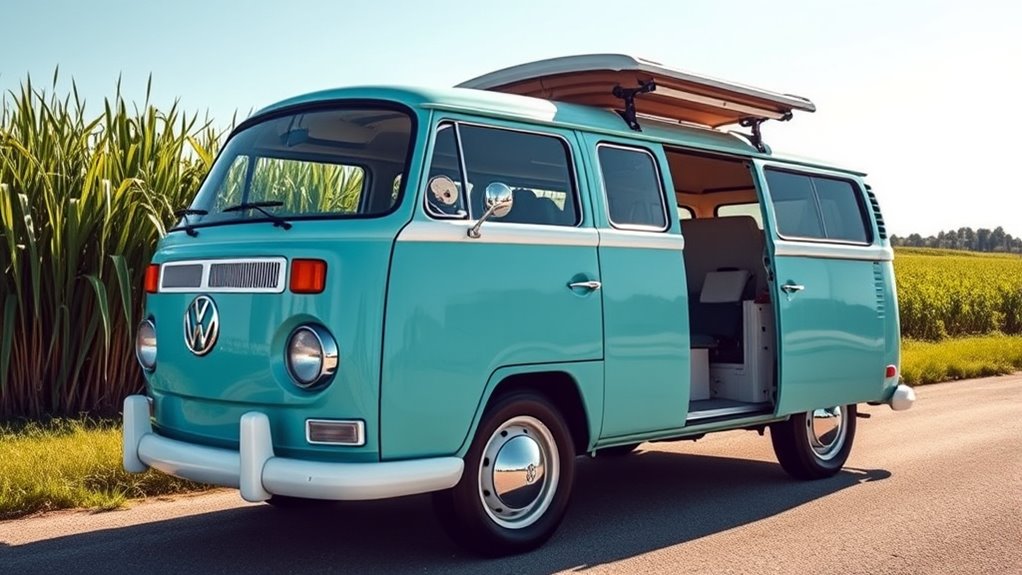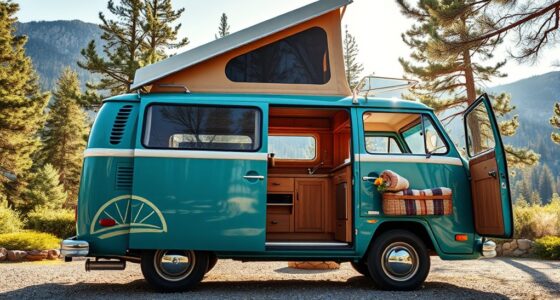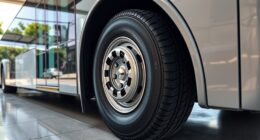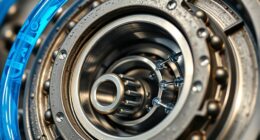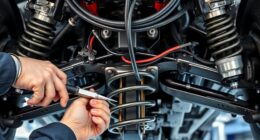To upgrade your vintage VW Bus with an EV heart, start by carefully planning battery placement to maximize space and maintain proper weight distribution. Choose high-capacity lithium-ion batteries that are securely mounted and protected from shocks. Select a high-torque or efficient brushless motor that fits smoothly into your drivetrain. Focus on safe wiring, cooling, and safety features to guarantee reliability. Keep the vintage look intact while blending in modern tech—continue exploring to discover all the essential steps involved.
Key Takeaways
- Plan battery placement within the chassis, ensuring secure mounting, space optimization, and easy maintenance access.
- Select high-capacity lithium-ion batteries and connect them efficiently for safety and enhanced range.
- Choose a high-torque, efficient motor, such as a brushless DC, to improve acceleration and hill-climbing.
- Incorporate proper wiring, cooling, and safety features to prevent overheating and electrical failures.
- Balance vintage aesthetics with modern tech by collaborating with specialists for seamless integration and safety compliance.

If you’ve ever dreamed of combining classic style with modern efficiency, upgrading a vintage VW Bus to electric is an exciting way to do it. The key to a successful retrofit lies in seamless battery integration and tailored motor customization. You want your restored bus to retain its nostalgic charm while delivering reliable, eco-friendly performance. That starts with carefully planning how your battery pack will fit within the chassis. You’ll need to consider the available space, weight distribution, and ease of access for maintenance. Opting for high-capacity lithium-ion batteries allows you to maximize range without overly compromising the vintage look. Proper integration ensures the batteries are securely mounted, protected from road shocks, and efficiently connected to your power management system. A well-executed battery setup not only enhances safety but also optimizes the overall performance of your EV conversion.
Once your battery system is in place, focus on motor customization. The motor is the heart of your electric VW Bus, and customizing it to match your driving needs is vital. You might choose a high-torque motor for better acceleration and hill-climbing ability or a more efficient motor for extended range. Modifying the motor’s specifications allows you to tune your vehicle’s performance precisely, ensuring it handles like a modern electric vehicle while respecting the vintage aesthetic. You’ll also want to consider the compatibility of your motor with the existing drivetrain and how to adapt it for smooth, silent operation. Many enthusiasts opt for brushless DC motors, which provide durability and efficiency, but the choice depends on your goals and technical skills.
Proper wiring, cooling systems, and safety measures must be incorporated to prevent overheating or electrical failures. The delicate balance between maintaining the vintage look and integrating modern technology is crucial for a successful retrofit. Throughout the conversion process, attention to detail in both battery integration and motor customization will pay off in the long run. It’s essential to work with knowledgeable suppliers or specialists who understand vintage vehicle constraints and modern EV technology. The goal is to create an electric drivetrain that delivers performance, reliability, and longevity, all while preserving the iconic look of your VW Bus. With careful planning and execution, your classic vehicle can become a stylish, eco-conscious ride that turns heads and sparks conversations. Upgrading to an EV isn’t just about going green; it’s about reimagining a timeless classic with innovative technology that respects its heritage.
Frequently Asked Questions
How Much Does a VW Bus EV Conversion Typically Cost?
A VW bus EV conversion typically costs between $10,000 and $20,000, depending on battery capacity and the complexity of the build. You’ll need to contemplate the charging infrastructure you’ll use, as higher-quality chargers can add to the overall expense. Budget for the battery pack, installation, and any necessary upgrades to your bus’s electrical system. Planning ahead helps you get the best value and a smooth conversion process.
Will Retrofitting Affect the Bus’s Vintage Value?
Retrofitting your VW bus to electric might impact its vintage appeal and collector value, but it depends on how you approach the upgrade. If you keep the original parts and maintain the classic look, your bus can still hold its charm. However, if the retrofit alters key vintage features, it could reduce its appeal for purists. You should weigh your goals carefully to preserve both the vintage feel and collector value.
How Long Does an EV Conversion Take?
Timing truly depends on your type of transformation. Typically, an EV conversion takes anywhere from a few weeks to a few months. You’ll need to plan for precise battery placement and verify motor compatibility, which can influence the timeline. If you’re organized and work with experienced experts, you’ll expedite the process, making your vintage vehicle vibrant and vroom-ready faster. Patience and preparation power a successful, seamless switch to electric!
Are There Any Legal or Registration Issues?
You might face legal or registration issues when converting your VW Bus to electric, especially concerning emissions regulations. Some jurisdictions require inspections or documentation to verify the vehicle’s emissions status, even if it’s now electric. The registration process may also need updates to reflect the new powertrain. Check local laws beforehand to make sure your conversion complies with all regulations and avoid surprises during registration.
What Is the Expected Range After Conversion?
You might worry about losing driving range after converting your VW Bus to electric. Rest assured, with a suitable battery capacity, you can anticipate a driving range of around 100 to 150 miles per charge, depending on your driving habits and conditions. Upgrading your battery guarantees you enjoy the retro vibe without sacrificing practicality. This way, your classic bus stays reliable and fun, ready for daily drives or weekend adventures.
Conclusion
By upgrading your classic VW Bus to electric, you’re not just preserving a beloved icon—you’re embracing a sustainable future. Some skeptics argue that retrofitting diminishes vintage charm, but recent innovations prove otherwise, blending nostalgic design with modern efficiency. With careful planning and the right components, you can enjoy eco-friendly cruising without sacrificing style. So, go ahead—transform your classic into a green machine and prove that tradition can meet innovation seamlessly.
